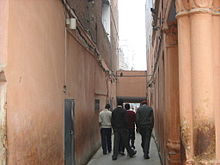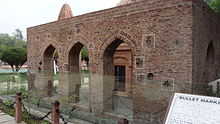Amritsar massacre
The Amritsar massacre , or more rarely the Jallianwala Bagh massacre , was perpetrated on April 13, 1919 in the northern Indian city of Amritsar by British soldiers and gurkhas of Sikhs , Muslims and Hindus who protested against the imprisonment of two national Indian leaders. Men, women and children were equally affected.
prehistory
India was the scene of mass demonstrations across the country initiated by the Indian National Congress in 1919 . From an Indian perspective, several social and political factors were to be classified as a nuisance: the Rowlatt Act , which allowed the arrest of persons classified as terrorist, the bad treatment of Indian veterans after their not insignificant use, especially in the Middle East during the First World War, and the arrest of local people Leader of the Indian national movement in Amritsar , Dr. Saifuddin Kitchloo and Dr. Satyapal. Within the movement, class differences in particular resulted in different ideas and conflicts about political goals. While those in the Congress Party who came from the educated class supported the nonviolent path of satyagraha ( soul power ) of Mohandas Gandhi , the majority of protesters did not. On the first day of the marches, April 6th, there was a Hartal .
An initially peaceful demonstration soon degenerated into violent acts. In response to the arson attacks on British-Indian authorities, banks and private owners, the then governor of Punjab , Sir Michael O'Dwyer , declared martial law. Brigadier General Reginald Dyer from the neighboring canton of Jullundur took control of the city. The instruction he had received from O'Dwyer read:
“No processions or crowds are allowed. All meetings are to be shot at. "
The massacre
The massacre took place in a walled park called Jallianwala Bagh . Some sources report that the soldiers warned against firing. The only escape route - namely the only entrance to this enclosed space - was blocked by the soldiers themselves. General Reginald Dyer sent a force of 150 foot soldiers armed with rifles and an armored car with a machine gun. Since the armored car could not get through the gate, it was not used.
According to official figures, 379 of the non-violent demonstrators were killed and 1,200 injured. The debate about the actual number of victims is still ongoing.
Back at headquarters, Dyer claimed to his superiors that he had been confronted with a "revolutionary army" and that because of this, the Punjab had to be taught "a moral lesson". Dyer held the rank of brigadier general only temporarily because of his position as commander of Jullub . To counter the protests that followed the incident, he was placed in an inactive state. For lack of command, he was demoted to colonel. The then commander in chief classified Dyer for further promotions as unsuitable.
Reactions
Winston Churchill condemned the event as follows:
"The incident at Jallian Wala Bagh was an extraordinary event, a monstrous event, an event that stands for itself in a unique and ominous way."
The massacre was unanimously condemned worldwide. General Dyer was summoned before the Hunter Investigative Committee, which was established in 1920 to investigate the massacre by order of Secretary of State for India Edwin Montagu . There he testified:
“I think it is quite possible that I could have broken up the meeting without shooting. Then they would probably have come back and laughed at me and I wasn't ready to make what I classify as 'ridiculous'. "
Dyer also confirmed that he would have had the machine gun deployed if the vehicle had been able to get inside the facility. He also did not order the cessation of fire when the gathering began to break up as he considered this counterproductive and therefore considered it his duty to keep shooting.
Dyer also admitted that he had not given any help to the injured because it was not his job and the hospitals were open.
At the time of his questioning, he was in poor health. This, together with the allegations and his testimony, led to his being advised to retire.
High British officers, on the other hand, welcomed the suppression of another "Indian mutiny". The House of Lords gave Dyer an explicit recommendation and the Conservative Party awarded him a gem-hung cross with the inscription "Savior of Punjab" on it. The Morning Post collected £ 26,000 to support Dyers.
To some British observers, Dyer was a hero who had maintained law and order in Amritsar. The writer Maud Diver wrote:
“Organized revolt is only amenable to the last argument - violence. At this point only courageous intervention and the compelling power of martial law help ... In Amritsar has already been intervened ... The sobering effect has spread widely and made life easier for thousands of members of both races. "
In India, the massacre provoked collective anger against the occupiers. It inspired the Indian independence movement in Punjab and, in the course of 1920, paved the way for Mohandas Gandhi's non-cooperation campaign as a mass movement of civil disobedience and for the entire Indian independence movement. The Nobel laureate Rabindranath Tagore resigned the title of nobility he had gained through the accolade in protest.
On March 13, 1940, the Sikh Udham Singh shot and killed the then governor of Punjab, Michael O'Dwyer, in London. Singh stated during the trial against him:
"He was it. He was the real culprit. He wanted to destroy the spirit of my people and that's why I destroyed him. "
Singh was executed for the act.
In October 1997, Queen Elizabeth II laid a wreath at the site of the massacre.
The day before, she had spoken of the massacre at the state banquet .
Work-up
- The event was portrayed in Richard Attenborough's 1982 film Gandhi, with Edward Fox in the role of General Dyer.
- The massacre is also discussed in the Hindi films Rang De Basanti - The Color Saffron and Phillauri .
literature
- Savita Narain: The Jallianwala Bagh Massacre. Lancer, Atlanta 2013, ISBN 978-1-935501-87-9 .
Individual evidence
- ↑ Imperium, James Laxer, p. 124, India's fight against the British "Raj"
- ↑ https://www.nytimes.com/1997/10/15/world/in-india-queen-bows-her-head-over-a-massacre-in-1919.html
Web links
- Excerpt from the Encyclopædia Britannica
- Arno Widmann: Violence, counter-violence and counter-violence. Berliner Verlag GmbH, Berliner Zeitung, April 13, 2013, accessed on April 16, 2013 .


